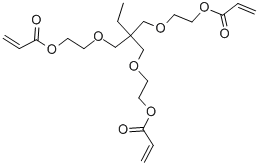Trimethylolpropane triglycidyl ether
Synonym(s):1,1,1-Trimethylolpropane triglycidyl ether;2,2′-(((2-Ethyl-2-((oxiran-2-ylmethoxy)methyl)propane-1,3-diyl)bis(oxy))bis(methylene))bis(oxirane);Triglycidyl trimethylolpropane ether
- CAS NO.:30499-70-8
- Empirical Formula: C9H19ClO4
- Molecular Weight: 226.7
- MDL number: MFCD00274208
- EINECS: 222-384-0
- SAFETY DATA SHEET (SDS)
- Update Date: 2024-12-18 14:08:57

What is Trimethylolpropane triglycidyl ether?
The Uses of Trimethylolpropane triglycidyl ether
Trimethylolpropane Triglycidyl Ether is used in method for producing pharmaceutical filler complex.
The Uses of Trimethylolpropane triglycidyl ether
Additive in fast-setting adhesives, low temperature curing coatings and hard, abrasion resistant castings and decoupage systems.
Definition
ChEBI: 2-({2,2-Bis[(2-oxiranylmethoxy)methyl]butoxy}methyl)oxirane is an epoxide.
General Description
Trimethylolpropane triglycidyl ether (TMPTE) has a trifunctional aliphatic glycidyl ether epoxide monomer mainly used as a crosslinking agent which provides chemical and mechanical resistance.
Properties of Trimethylolpropane triglycidyl ether
| Density | 1.157 g/mL at 25 °C (lit.) |
| refractive index | n |
| Flash point: | >230 °F |
| solubility | Chloroform (Sparingly), Methanol (Slightly) |
| EPA Substance Registry System | 1,3-Propanediol, 2-ethyl-2-(hydroxymethyl)-, polymer with (chloromethyl)oxirane (30499-70-8) |
Safety information for Trimethylolpropane triglycidyl ether
| Signal word | Danger |
| Pictogram(s) |
 Corrosion Corrosives GHS05  Exclamation Mark Irritant GHS07  Health Hazard GHS08  Environment GHS09 |
| GHS Hazard Statements |
H314:Skin corrosion/irritation H317:Sensitisation, Skin H341:Germ cell mutagenicity H351:Carcinogenicity H361:Reproductive toxicity H411:Hazardous to the aquatic environment, long-term hazard |
| Precautionary Statement Codes |
P202:Do not handle until all safety precautions have been read and understood. P273:Avoid release to the environment. P280:Wear protective gloves/protective clothing/eye protection/face protection. P303+P361+P353:IF ON SKIN (or hair): Remove/Take off Immediately all contaminated clothing. Rinse SKIN with water/shower. P305+P351+P338:IF IN EYES: Rinse cautiously with water for several minutes. Remove contact lenses, if present and easy to do. Continuerinsing. |
Computed Descriptors for Trimethylolpropane triglycidyl ether
New Products
Tert-butyl bis(2-chloroethyl)carbamate 4-Methylphenylacetic acid N-Boc-D-alaninol N-BOC-D/L-ALANINOL 3-Morpholino-1-(4-nitrophenyl)-5,6-dihydropyridin- 2(1H)-one Furan-2,5-Dicarboxylic Acid Tropic acid 1,1’-CARBONYLDIIMIDAZOLE DIETHYL AMINOMALONATE HYDROCHLORIDE R-2-BENZYLOXY PROPIONIC ACID 1,1’-CARBONYLDI (1,2-4 TRIAZOLE) N-METHYL INDAZOLE-3-CARBOXYLIC ACID (2-Hydroxyphenyl)acetonitrile 4-Bromopyrazole 5-BROMO-2CYANO PYRIDINE 5,6-Dimethoxyindanone 5-broMo-2-chloro-N-cyclopentylpyriMidin-4-aMine 2-(Cyanocyclohexyl)acetic acid 4-methoxy-3,5-dinitropyridine 2-aminopropyl benzoate hydrochloride 1-(4-(aminomethyl)benzyl)urea hydrochloride diethyl 2-(2-((tertbutoxycarbonyl)amino) ethyl)malonate tert-butyl 4- (ureidomethyl)benzylcarbamate Ethyl-2-chloro((4-methoxyphenyl)hydrazono)acetateRelated products of tetrahydrofuran








You may like
-
 (2-Ethyl-2-(hydroxymethyl)-1,3-propanediol polymer with (chloromethyl)oxirane CAS 30499-70-8View Details
(2-Ethyl-2-(hydroxymethyl)-1,3-propanediol polymer with (chloromethyl)oxirane CAS 30499-70-8View Details
30499-70-8 -
 1975-50-4 98%View Details
1975-50-4 98%View Details
1975-50-4 -
 2-HYDROXY BENZYL ALCOHOL 98%View Details
2-HYDROXY BENZYL ALCOHOL 98%View Details
90-01-7 -
 2-Chloro-1,3-Bis(Dimethylamino)Trimethinium Hexafluorophosphate 221615-75-4 98%View Details
2-Chloro-1,3-Bis(Dimethylamino)Trimethinium Hexafluorophosphate 221615-75-4 98%View Details
221615-75-4 -
 61397-56-6 CIS BROMO BENZOATE 98%View Details
61397-56-6 CIS BROMO BENZOATE 98%View Details
61397-56-6 -
 14714-50-2 (2-Hydroxyphenyl)acetonitrile 98+View Details
14714-50-2 (2-Hydroxyphenyl)acetonitrile 98+View Details
14714-50-2 -
 118753-70-1 98+View Details
118753-70-1 98+View Details
118753-70-1 -
 733039-20-8 5-broMo-2-chloro-N-cyclopentylpyriMidin-4-aMine 98+View Details
733039-20-8 5-broMo-2-chloro-N-cyclopentylpyriMidin-4-aMine 98+View Details
733039-20-8
Statement: All products displayed on this website are only used for non medical purposes such as industrial applications or scientific research, and cannot be used for clinical diagnosis or treatment of humans or animals. They are not medicinal or edible.